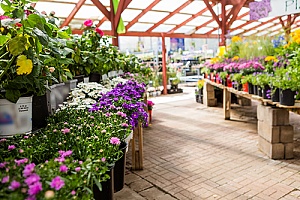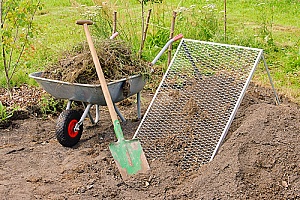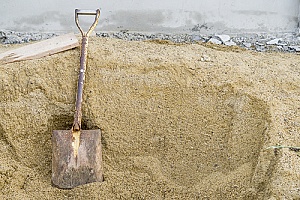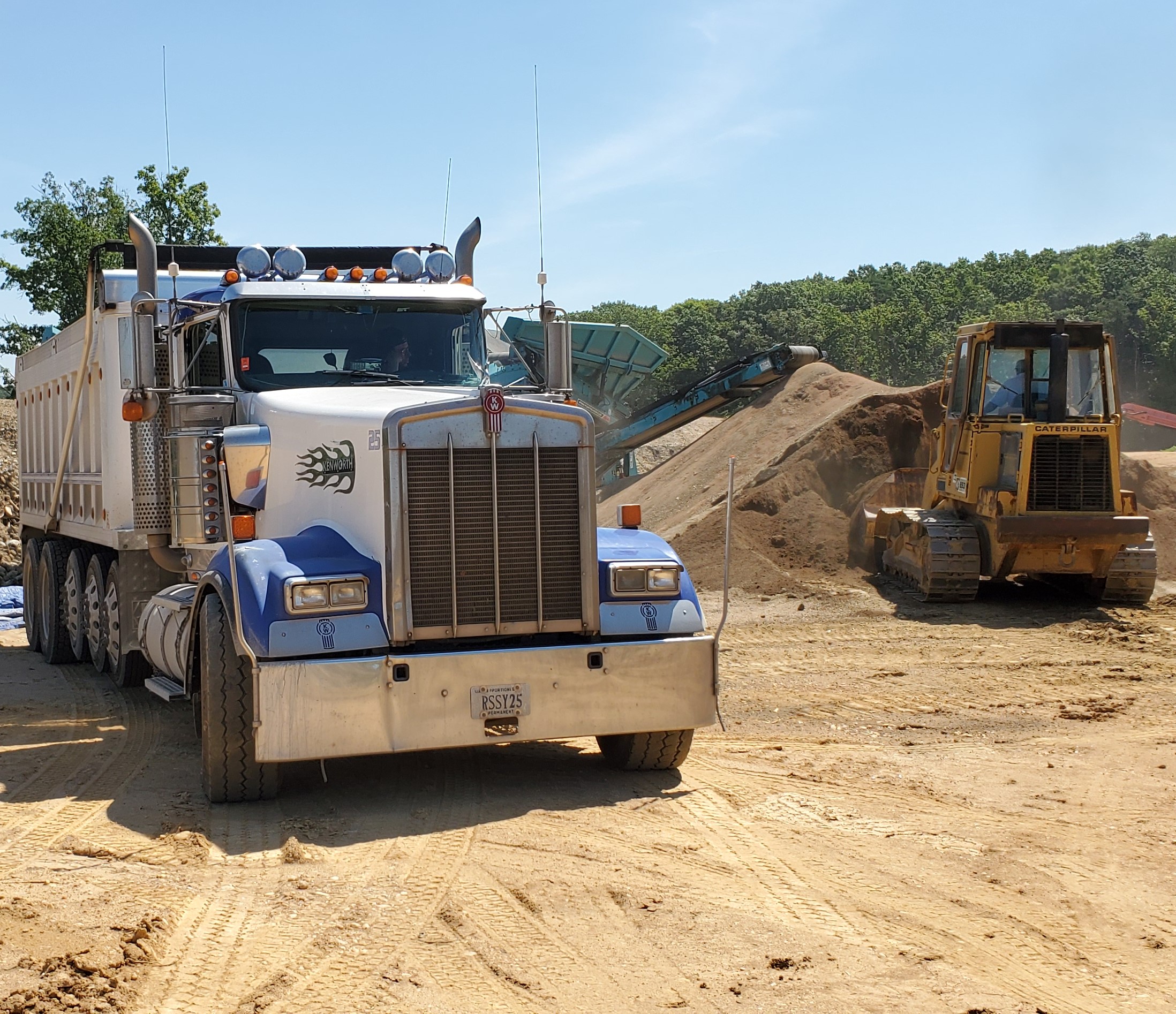Discover what topsoil is and what and how to make the most of this organic material.
Topsoil or organic topsoil is known as the upper layer of a soil profile.
Topsoil is produced as a result of some natural biological and environmental processes. The depth of topsoil ranges from 2 – 12 inches in depth. This layer is the strong base of most biological activity. This base material consists of the highest concentration of microorganisms and organic matter, due to animal decomposition, plants, etc.
The primary elements of the topsoil composition are:
- Organic matter
- Mineral particles
- Air
- Water
The strength of the soil, including its bearing capacity, hinges on its skeletal form and reduces with the presence of organic matter. Water run-off leads to minerals from the topsoil layer moving down into the subsoil. This effect can result in some mineral shortage in the topsoil. The effect of this process is that roots have to go deeper to obtain nutrients. During construction, it is essential to remove the topsoil. Topsoil removal can cause an increase in the rate of erosion of soil minerals.
Topsoil is something all yard needs, but few people don’t have the appropriate knowledge of its use. Organic rich material allows for the sprouting of plants and grass. A clear understanding of the topsoil composition, and it’s best usage, can help you maintain your lawn and garden.
The Components of Topsoil
The topsoil layer is a significant part of all types of lawns and gardens because of its contents. Topsoil boasts of a large quantity of organic matter, including microorganisms. As vegetables, plants, and a host of other organic matter withers, it gradually disintegrates, and the nutrients go back to the topsoil, which is its origin. Organic matter and microorganisms can hugely assist with growing and preventing bacterial that may cause problems with plants.
Other constituents present in the topsoil are sand, manure of several types, and tiny pieces of rocks and stones. The topsoil composition varies with location; it has various appearances and isn’t similar everywhere.
 Where to Find Topsoil
Where to Find Topsoil
You can find smaller topsoil quantites at your local gardening center. Bulk topsoil can be purchased at Dirt Connections. Topsoil is often bought as a mixture of sand, clay, and silt. Knowing the type of soil you need will help will determine where to buy topsoil.
How to Use Topsoil
The best place to use topsoil is in your yard. That is to say; a top-notch composition is all that is required to ensure that your plants, trees, and vegetables remain healthy and fresh. Topsoil can also stop weed and pests from preying on your plants.
Utilizing topsoil purchased from stores can safeguard bulbs and root systems, including the buds that are still growing under the soil. Topsoil is cheaper than garden soils. Garden soils usually boast a specific blend of nutrients.
Topsoil may not be the perfect choice when you require something to cover your unique gardening project. Dirt Connections can provide organic screened topsoil.
How to Figure Out the Amount of Topsoil That You Need
If you want to fill a raised bed or make a berm, you might want to make use of topsoil. If you’re going to fill a garden bed, you will require a minimum of 8 inches of depth of topsoil. New lawns are okay if you desire to disperse a layer of 3-5 inches of topsoil before planting. For help with material quantities, email Dirt Connections. Send us the length, width and depth. We can provide you with cubic yard quantities.
Where to Use Topsoil
Topsoil has several uses; garden beds, borders, or for laying of turf or sowing grass seed and can be utilized in raised beds for the growing of several plants, and vegetables.
Grades of Topsoil
Topsoil can be obtained in three grades: General purpose, economy, and premium. The above mentioned classifications are greatly focused on the finesse of the soil and the quality it offers in terms of allowing flowers and plants to grow.
Economy
This grade of topsoil, which is also known as “As Dug,” is the least grade of topsoil and is unscreened. This material will contain foreign organic materials. Economy grade topsoil or fill dirt is is less expensive. It’s ideal to fill large depressions on your property.
General Purpose
Topsoil is beneficial for most garden projects. This material is also perfect for landscape gardening. The soil is rich nutrients.
Premium
This type of material is harvested from the top 2 -12 inches of earth. This material is then processed through a screening machine. This will remove any materials larger than 3/4 of an inch. Dirt Connections provides screened topsoil and screened fill dirt.
How to Enhance Material
Dirt Connections provides for Bio Mix Soils for specific projects with soil testing results.
What is Screened Topsoil?
 There exist several variations of diverse categories of topsoil which are utilized for so many purposes, generally.
There exist several variations of diverse categories of topsoil which are utilized for so many purposes, generally.
Screened topsoil has several benefits, one of which is that it has an even size which aids the best water flow and distribution of significant nutrients, which will ensure that your garden stays healthy.
Unscreened topsoil doesn’t go through any screening process. This type of topsoil is always uneven and coarse and can contain root matter, stones, branches, leaves and other materials.
Use of Topsoil In Repairing Lawn Damage
You can fill a deep space of grass by including a 2-inch-thick layer of topsoil. The grass can sprout through the new topsoil. Fill an empty area in your lawn by dispersing a 1-inch-thick layer of topsoil on the site. You can the spread grass seeds on that area. Daily care will result in new grass.
Use of Topsoil in Improving Drainage of the Soil
Filling topsoil in an area of lawn or garden that can hold water enhances the drainage of the location.
Types of Topsoil
There exist three primary types of topsoil. They are as follows:
1) Sand
 Sand consists of mineral particles and neatly separated rocks. This is a highly variable of topsoil and its hinges on the category of available local rock in the vicinity. There are two common types of sand; they are silica and aragonite.
Sand consists of mineral particles and neatly separated rocks. This is a highly variable of topsoil and its hinges on the category of available local rock in the vicinity. There are two common types of sand; they are silica and aragonite.
2) Loam
This material consists of uniformly concentrated levels of constituents such as silt, clay, and sand. You can find loam in big fertile lands and is very good for farming.
3) Clay
The third and ultimate type of topsoil is the clay. Clay is from decomposed organic substances. These organic materials combined with powder from rocks makes clay.
How Topsoil Improves Garden Health
Topsoil plays a crucial role in enhancing garden health. Using high-quality topsoil, like screened topsoil, boosts the growth of plants and vegetables by providing essential nutrients. It helps in creating a robust environment for root development and improves soil drainage. When you use topsoil effectively, it can also prevent erosion and support healthy grass growth. For a thriving garden, consider topsoil options that best suit your soil type and needs. Remember, incorporating longtail keywords such as “organic topsoil for gardens,” “screened topsoil benefits,” and “how to improve garden soil” can help in finding the right product for your project.
Summary
You have discovered what topsoil is and how and where to make the most of this organic material. In addition, you now know Dirt Connections can provide you with screened topsoil, screened fill dirt and unscreened fill dirt. If you have any questions, contact our office.












































